What is SEO Competitive Analysis?
SEO competitive analysis is the process of identifying the strengths and weaknesses of your and your competitors' SEO.
Much like a typical competitive analysis, you're working to discover any gaps between you and your competitor. But rather than focusing on marketing strategy, you'll focus on SEO strategy.
A competitor analysis can help you:
Benchmark your current SEO performance Identify areas of improvement in your SEO strategy Reveal any competitor gaps or weaknesses Discover your competitors' winning strategiesWhy SEO Competitive Analysis is Important
Running a competitive analysis allows you to review your overall market, competitors, and how the current search landscape works for important keywords.
Even if you are already ranking at the top of the search results for your most important keywords, you'll need to monitor your SEO performance to ensure you don't lose your rank to a competitor.
How to Run an SEO Competitive Analysis
There aren't any hard or fast rules to running an SEO competitor analysis, but here are a few steps you can add to your process:
Find Your Competitors
Start by making a list of who you consider your competitors. (If you're working with a client, ask their marketing team or stakeholders to contribute.) Try to focus on websites that rank highly or often for your main target keywords and any significant additional keywords.
If you're working on a new website, you may not already know who your competitors are. You can try building your list with the Market Explorer tool. Select "Find Competitors" on the tool's landing page, then enter your domain.
The tool automatically visualizes a list of significant players in your market niche with the Growth Quadrant:
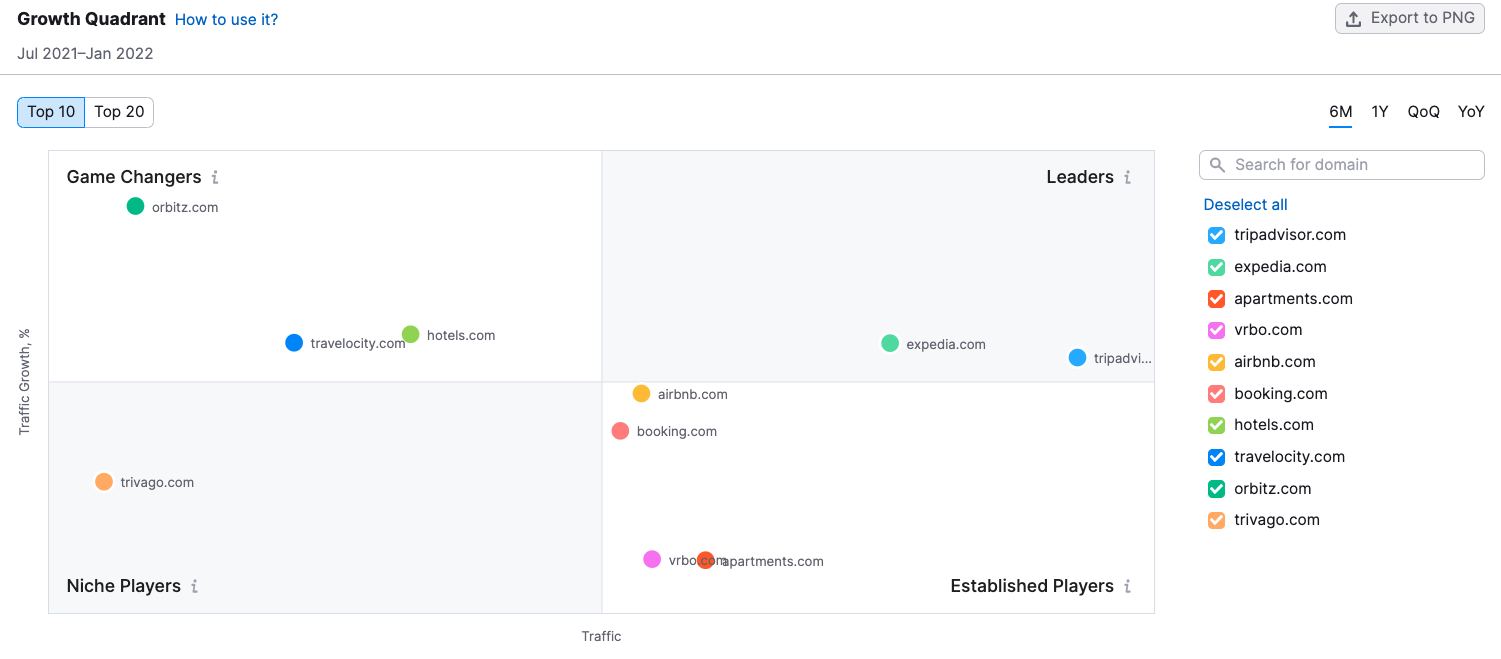
The Growth Quadrant chart sorts you and your competitors into four basic categories:
Niche Players: New or small companies with smaller audience size and a low growth rate Game Changers: Emerging companies with a comparatively smaller audience size but who are growing quickly Leaders: Companies with both a large audience and a rapid growth rate. Established Players: Companies with large, established audiencesHover over each entry to see their direct traffic, search traffic, and more. You can also view this information in the All Domains tab.
If you already know your competitors, you can use the Market Explorer tool to track them by creating a list. Select "Create List" on the tool's landing page, enter your and your competitors' domains, then name your list:
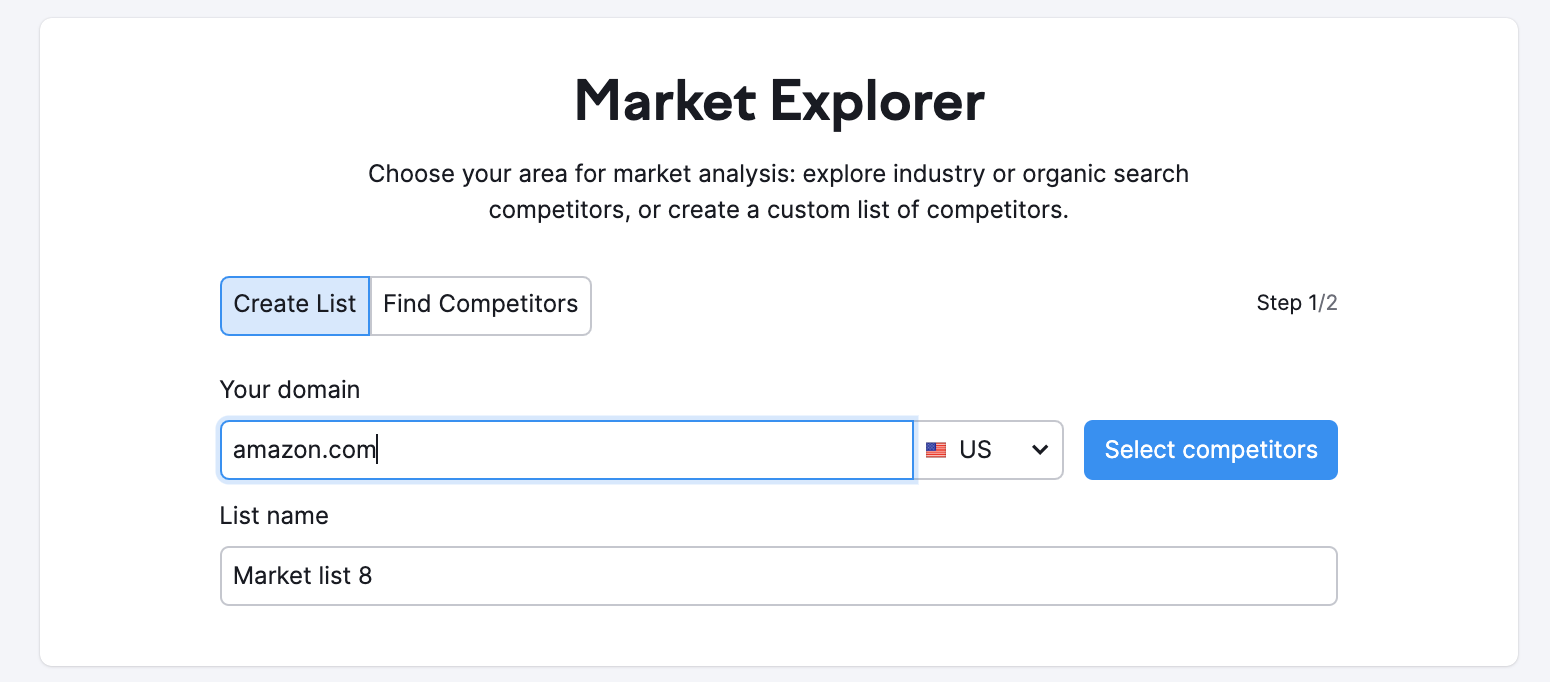
With an SEO competitive analysis, it's important to remember that your biggest competitor might not always be the one grabbing all the top rankings.
You're also competing with other sites for long-tail or branded keywords, so don't be afraid to incorporate those keywords into your review. If you focus solely on general keywords, your keyword analysis could be skewed or ultimately unhelpful.
You should also consider competitors for a specific segment of your overall market. For example, we can see in the Organic Competitors report of the Organic Research tool that Home Depot's organic search competitors include other hardware stores like Lowe's, but also other stores that sell tools, like Sears or Amazon:
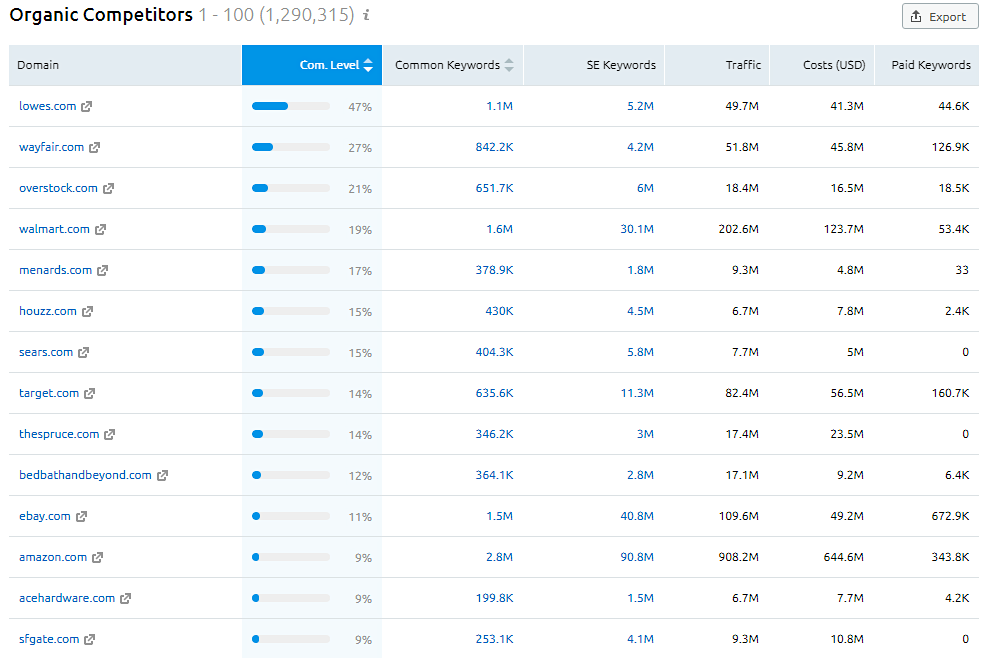
Limiting Home Depot's analysis to other hardware stores would create a considerable gap in their results. They'll also need to consider other stores that offer similar products or services, even if those stores aren't in their niche market.
Deciding Who Not to Compete With
Every competitor above you in the SERPs won't be a true competitor. In the same vein, it may not be as essential or even viable to try to outrank some sites.
To identify which sites aren't your competitor, consider factors like current ranking, resources, and time investment.
Sometimes it may not be worth trying to outrank sites like Wikipedia or Pinterest for specific keywords. Or you may need to dedicate more effort to outranking sites that are much bigger or much more established, which can affect your overall strategy.
Instead, focus on the competitors that can impact your traffic the most. These will likely be the websites that contribute the most to your lost traffic.
Analyze Your Competitors' Top Pages
It's also essential to identify your competitors' most popular pages.
Things to take note of:
Which pages rank for the most keywords? Which pages have the most traffic? Which pages have the highest percentage of their overall traffic?Sometimes competitors can drive considerable traffic to a particular page or set of pages. For example, the third most popular page on Home Depot has nothing to do with building supplies or construction but rather a page about wallpaper.
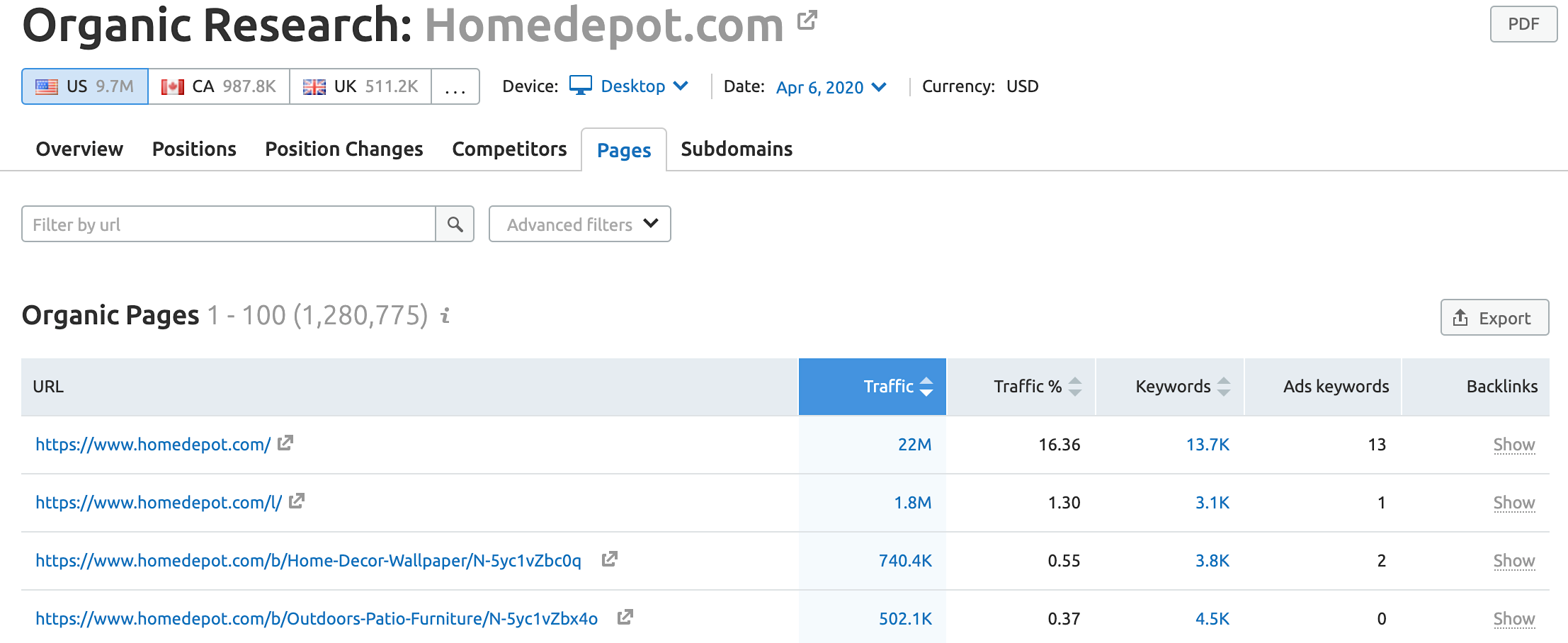
Never assume you know the most popular pages on any competitor site. Research it as part of the competitive analysis process and expect some surprises.
Find (and Close) Keyword Gaps
Pay special attention to the keywords that you already rank for, but not as well as your competitors. Take particular note of keywords where you are only a position or two behind your primary competitor.
Use the Keyword Gap tool to identify your competitors' keywords you share and don't share. Start by entering your site and up to four competitor sites to see the Overview report, which then indicates top keyword opportunities for you:
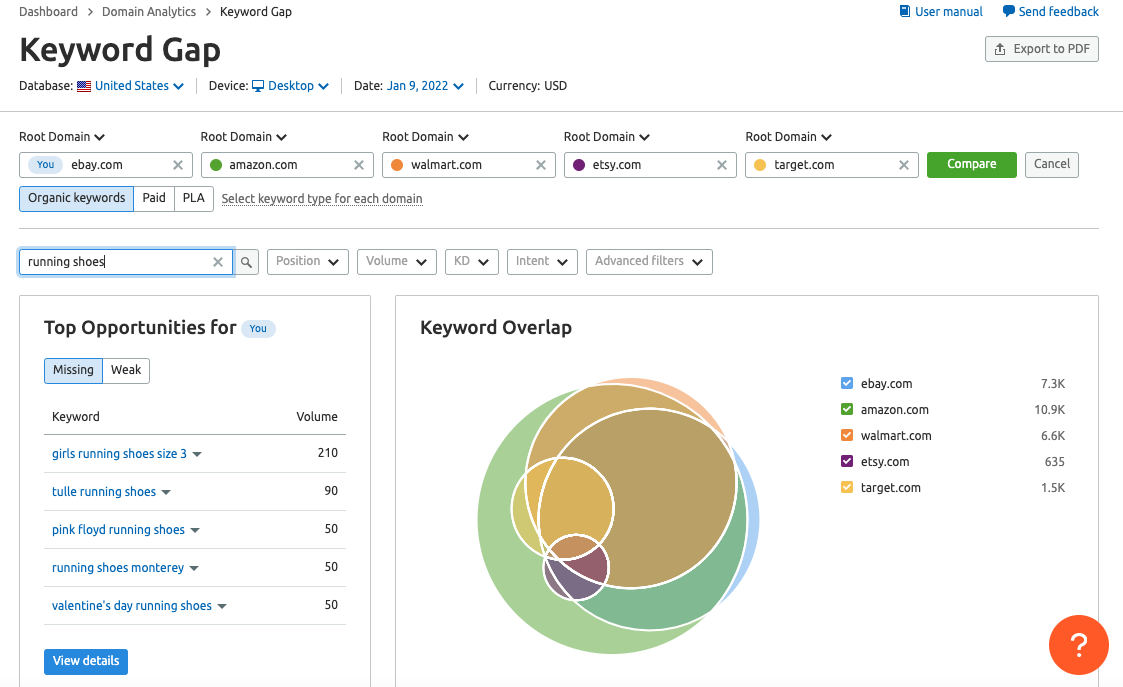
The Keyword Gap tool provides a detailed look at the competitor's search landscape for any chosen search term. When you can identify any gaps in that landscape, you can work on closing or taking advantage of them.
For example, suppose I was Home Depot. In that case, I could identify some keywords where I am only one position away from the top spot, such as for "swing sets" and "air compressor" keywords (see image below), both of which have a reasonably large search volume.

Again, don't just look at your main competitor. For example, while Home Depot dominates on many of the search terms shared by all competitors, it isn't just Lowe's that has earned the number one rankings sometimes; it is Walmart or companies selling similar products.
In the case of "appliance stores," none of the four competitor examples I showed were ranking number one for that phrase, although they were each in the top 10 or 20. Instead, it was Sears Outlet that took the top spot.
You should pay attention to keywords that all your competitors are ranking for, but you are not.
Why are they ranking and not you? Do they have better supplementary content for those particular keywords? Do they have an exceptionally higher number of backlinks to those specific pages that are helping them rank higher? What do you need to do on your site to target those individual keywords?Identify Strengths and Weaknesses
What are the differences in strengths and weaknesses between you and each one of your competitors? Where do they excel that you don't?
Every website will have at least one weak point, even massive eCommerce sites like Amazon or eBay.
If you are struggling to determine the weak areas with your site, ask employees what they see, especially if they're front-facing, and deal with customers who may have voiced complaints. You can also create a customer survey.
Even your strengths may need a little tweaking. If there's a tactic or strategy you and your competitors share, try determining some ways your competitors' execution differs from yours.
Identify the strong and weak points of each of your competitors by considering these factors:
Authority
How authoritative is your site compared to your competitors? Do they have many essential links coming into the site? Are they from a well-known brand authority?If your competitor has a much higher authority than your site, you will have a more challenging time outranking them for highly competitive keywords; this is essential to look at keyword gaps.
Look at less popular terms that still see a decent amount of search volume, or look at longer-tail queries that you can target specifically but that they are not targeting. As you build your authority, you can start being more successful in targeting some of these more popular and competitive keywords.
Content
Do they have excellent quality content? Does their content tend to be thinner and less thorough? Do they simply focus on product pages and not have any supporting pages? Are they only creating one type of content or several?Review each competitor's content manually to make a list of any strengths or weaknesses you notice. Look for any gaps in their content that you can take advantage of with your own.
You can also use the Content Analyzer to review your content for strengths or weaknesses. The tool reviews pages of each site subfolder you specify for essential metrics like total clicks, total impressions, and any related search queries. Once connected to Google Search Console, it can also tell you if the page's metadata, headings, or body content needs improvement.
To get started with the Content Audit tool, select the subfolders you want to audit. If the list is missing necessary subfolders or URLs, you can link the tool to your website's sitemap or upload the sitemap in .txt, .xml, or .csv format.
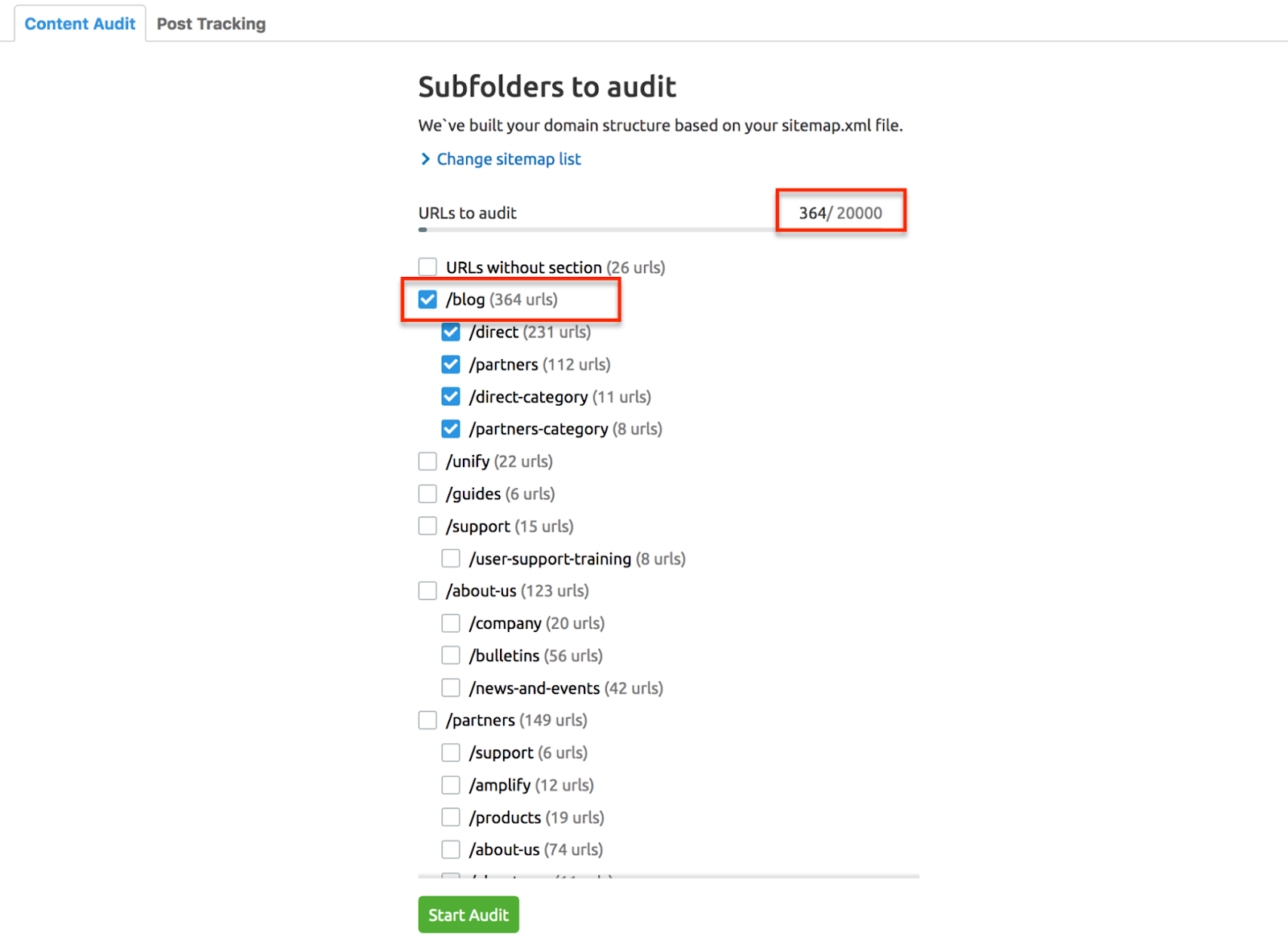
Once the audit is complete, you can review results by content sets or the table. Content sets categorize each URL by the type of improvements needed. You can also build your custom content set to organize your content.
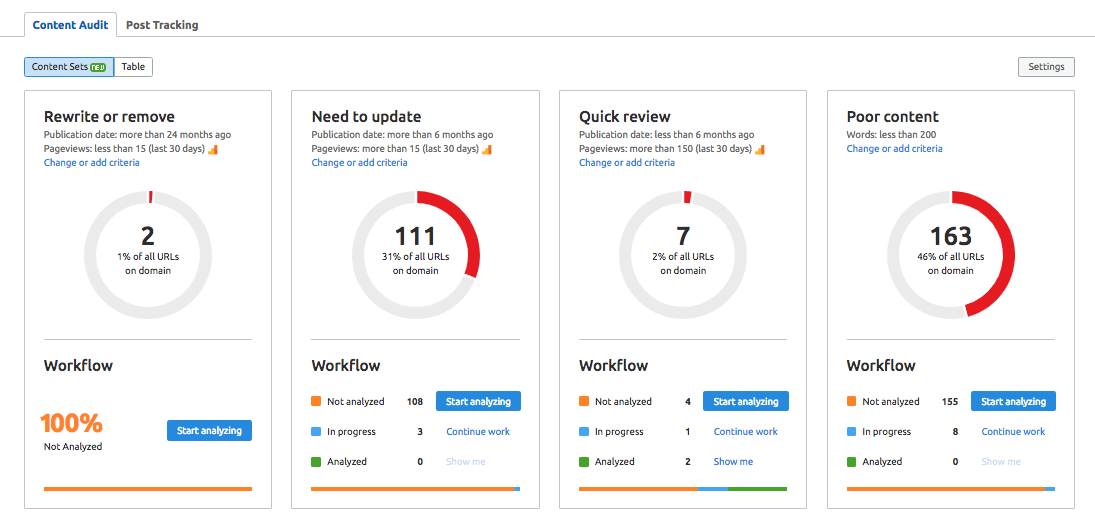
Select each URL to review its metadata and metrics, then take notes or create tasks around the page's improvement.
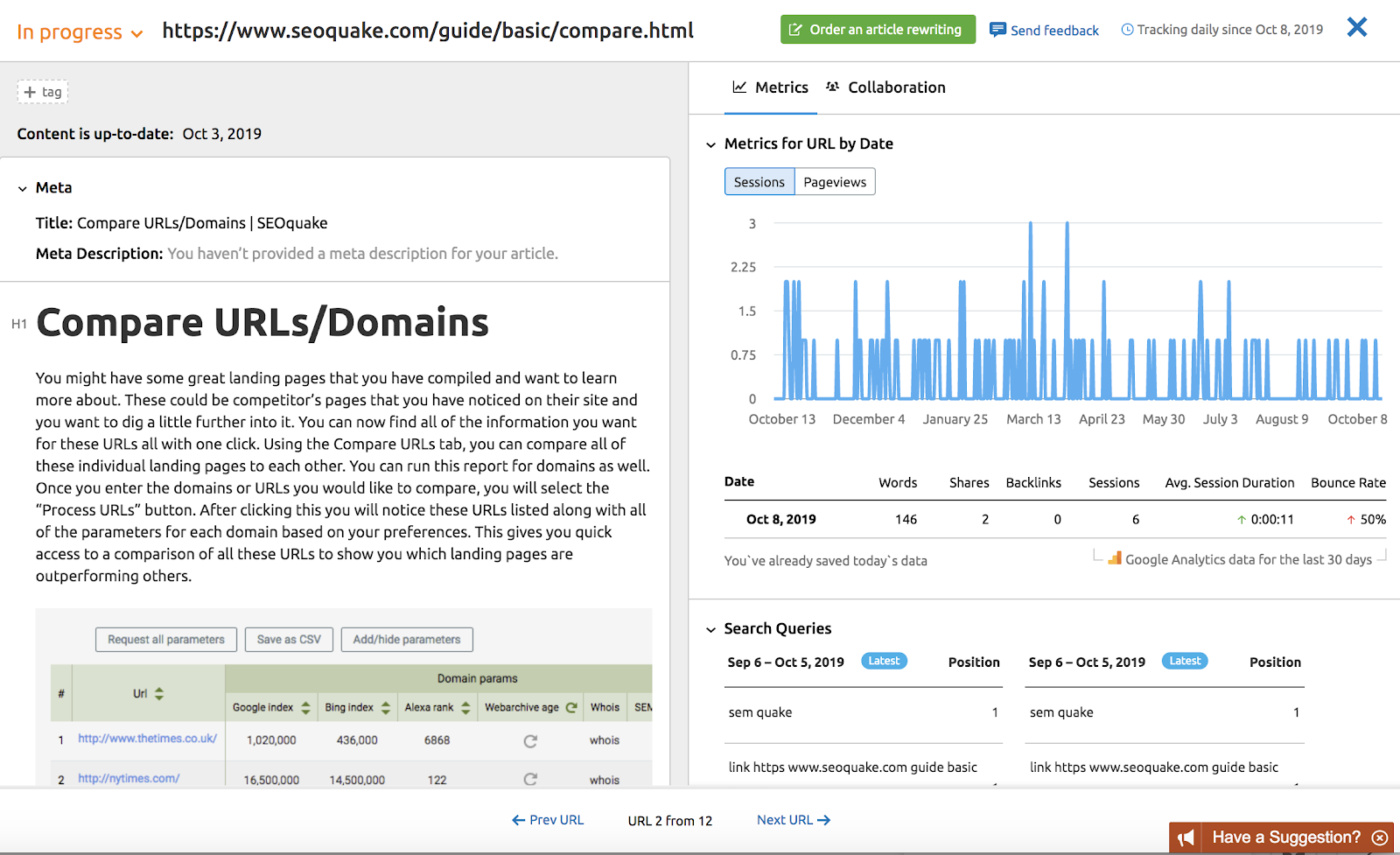
eCommerce
Look at their product pages for e-commerce sites and drill down exactly what it is about their product pages that are better than what you are doing.
Do they have links to help guides or supports for the product? Do they have lots of how-to's related to the product? Are they suggesting relevant similar products or products that are often bought together? How are they showing their ratings and reviews for the product? How easy is it to purchase their product versus yours?Technical SEO
Do they have any technical issues on their site hindering their search performance?
If you are both suffering from the same technical SEO issues or having coding issues that make it harder for Google to crawl pages effectively, making those improvements to your site can result in more visibility.
Don't forget to check page speed as well. As sites get larger, they can get bogged down by legacy code or large scripts that can slow down.
You likely won't have access to your competitors' technical SEO, but you can use the Site Audit tool to stay top of yours. The Site Audit tool is a high-powered website crawler that performs over 120 site checks, including:
duplicate content broken links HTTPS implementation crawlability indexabilityUse the tool to set a benchmark and regularly monitor your site's health.
Mobile
Visit each competitor's site from a mobile phone, and navigate their more popular sections or pages. Sometimes you will spot shortcomings in your competitor's mobile site that you can take advantage of with your strong mobile presence.
Having a technically sound website makes it easier to focus on other issues with ranking wins, such as improving content.
Internal Linking Issues
Internal linking and hierarchy of the site help Google crawl, index, and ranking. Site architecture is an essential aspect of SEO. Like technical issues, if an area lacks a robust internal linking structure, you can take advantage of that if your own is solid.
Examine how competitors have structured their site, including URLs, breadcrumbs, and anchor text. If theirs is strong, and yours is lacking, then it should be one of the tasks prioritized for fixing.
You can use the Backlink Analytics tool to see your and your competitor's backlink structure. Enter your competitor's domain in the tool's input field to get started with the tool. (If you want to see the links that point to a specific page on a site, enter the URL of that page, rather than the root domain - e.g., www.yourwebsite.com/page.)
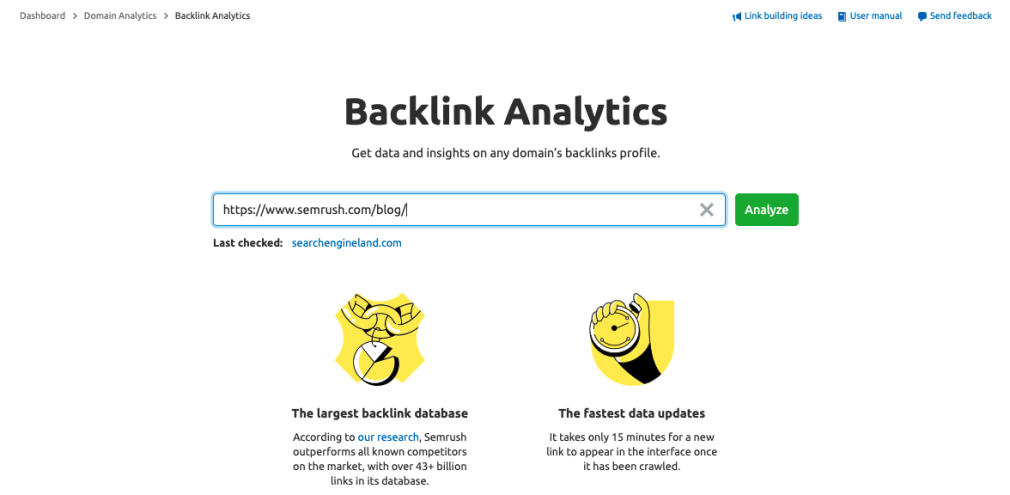
Select "Analyze" for an overview of the backlink profile for the domain or page that you've entered, with key insights like their Authority Score, number of referring domains, and even anchor text:
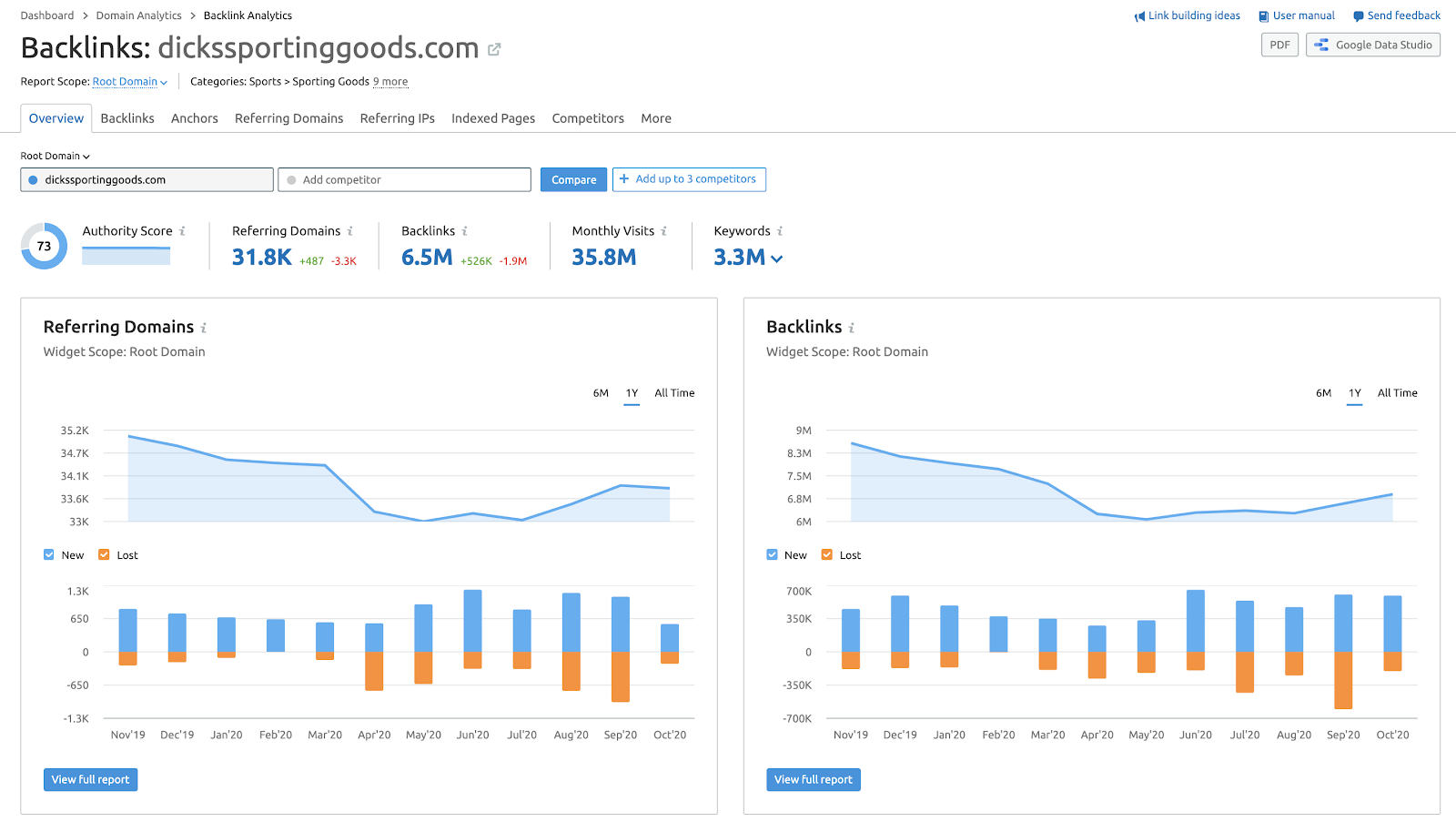
Use the Backlink Audit tool to see your site's backlink profile, then compare it to your competitors. Start by opening the tool and entering your domain, brand name, domain category, and target country.
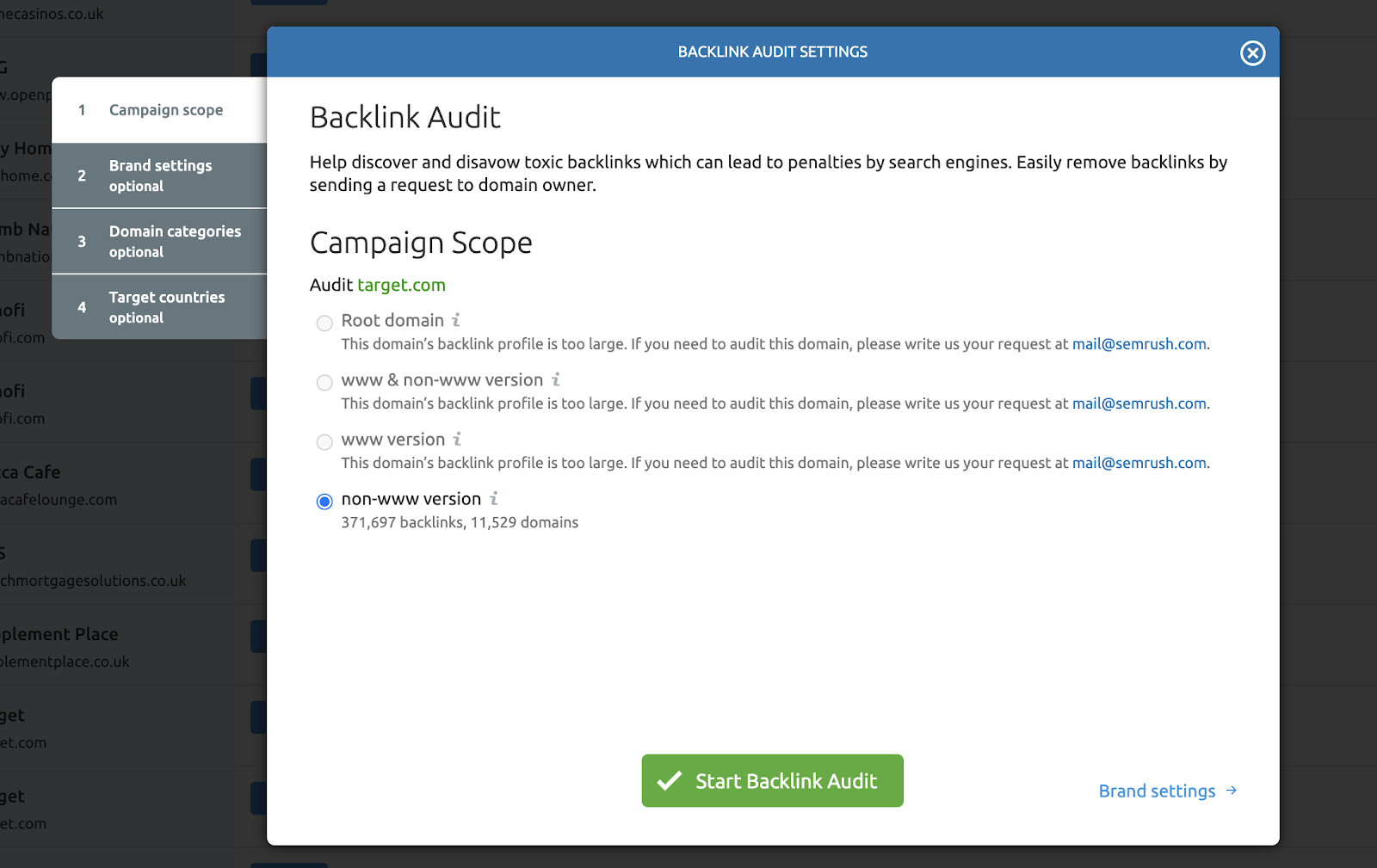
Select "Start Backlink Audit." Once completed, the tool will return an overview of your site's backlink profile, including its overall toxicity score:
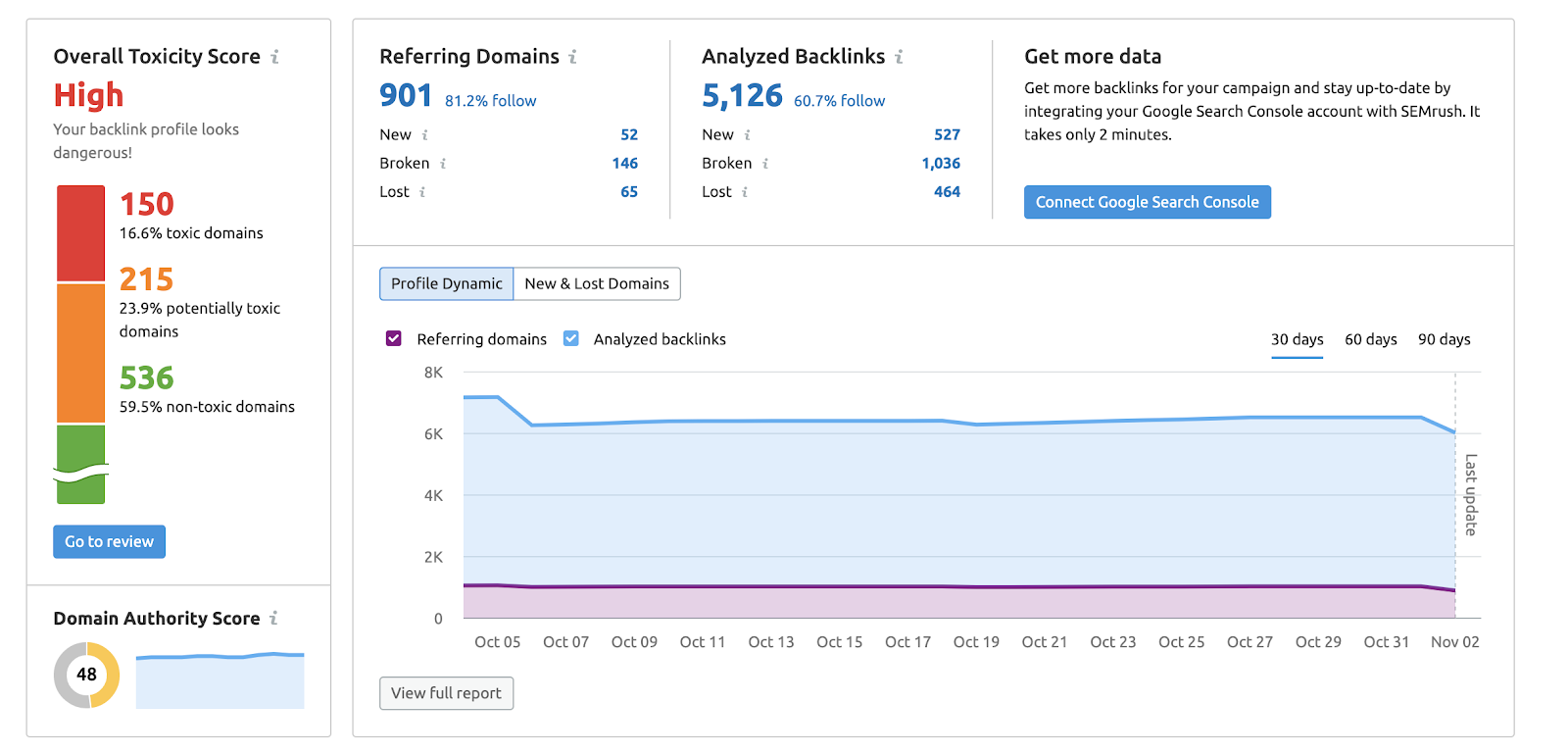
Pay special attention to the overall toxicity score and the specific breakdown of toxic, potentially toxic, and non-toxic domains.
This score can indicate that you need to take action on specific links or domains either by adding to your disavow file or by getting these links removed to prevent any negative impact resulting from such links.
Sometimesranking losses can be attributed to technical or poor internal linking that makes the site less Googlebot-friendly, meaning it is not necessarily from a Google algorithm change.
Lost and Declined Keyword Rankings
You also want to be sure you research any keywords that your competitors have recently lost, focusing on those with the highest search volume first.
You could also look at the pages that used to rank for the keywords and see if there is a reason why they are not ranking any longer — it could be a wide range of issues, from a technical crawl issue to a spam issue.
Competitor Lost Rankings
When a competitor has significantly lost rankings for specific keywords, it can be easy to capitalize on those losses and turn them into your wins. You can find those losses in the Organic Research tool.
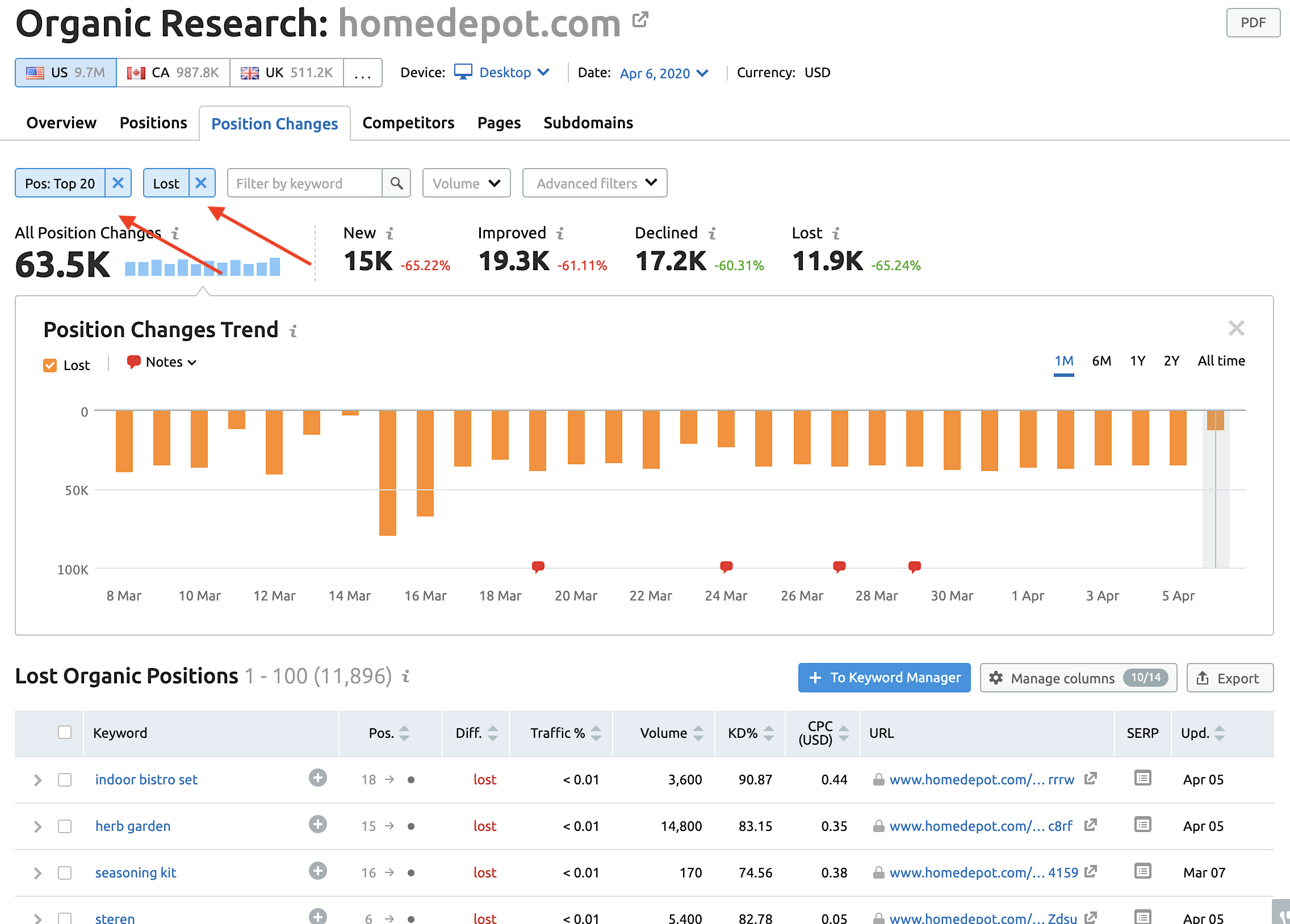
Have a look at where they are declining in the search rankings. This can present some opportunities for your site to take advantage of, particularly when the competitor hasn’t noticed their losses and are not working to fix whatever caused the ranking drops in the first place.
New Keyword Rankings
Looking at new keyword rankings is another critical aspect of competitive analysis. You should aim to do it fairly regularly for general SEO purposes.
You always want to know any new pages or new rankings that your competitors are earning, so this is an easy way to see anything new there focusing on. For eCommerce sites, it can be an insight into any new products or product types that could potentially become popular that you want to know about.
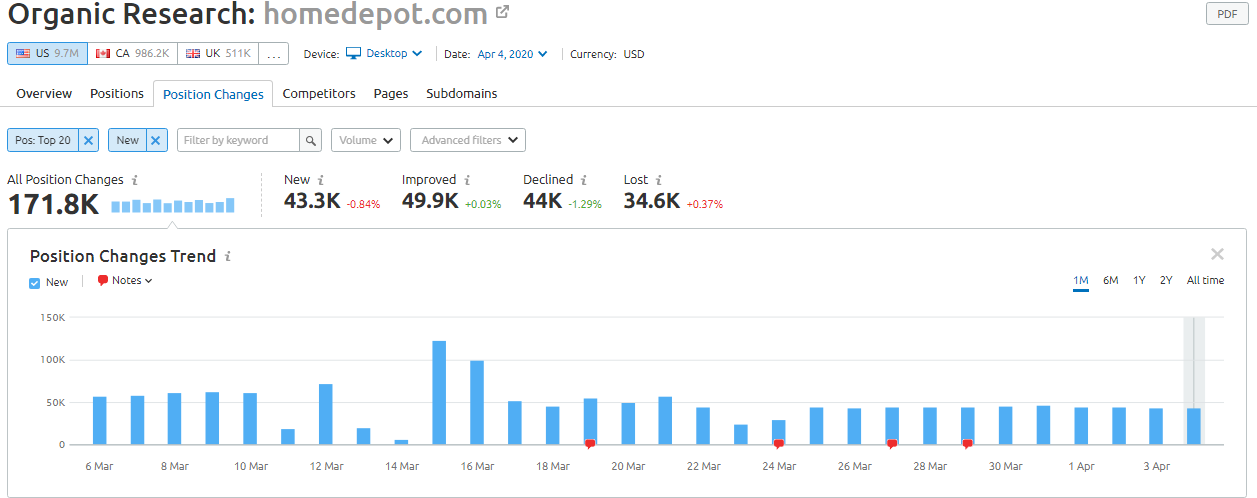

One word that stands out here is "bidet," a keyword that has seen a massive surge in popularity due to toilet paper shortage.
As I researched this particular new ranking for the term bidet, I noticed that this site is not ranking with a product page but instead ranking with a "how to use a bidet" guide, which links through to products.
What exactly is ranking?
It is essential to understand what keywords a competitor is ranking for and the page type that is ranked because many could have made the wrong assumption that they were ranking for a product page. This would also be helpful to know if you are adding your own competing pages; you would want to focus on not just product pages for bidet but also how to type pages.
Analyze On a Page by Page Basis
Once you have identified specific keywords and search results, you'll need to start looking on a page-by-page basis, comparing your pages to the competitors' pages that are outranking you.
Comparing pages will help you identify individual issues on each page resulting in your competitors ranking higher than you. It will also help you understand what you should be doing better on those particular pages.
Titles
While Google does rewrite title tags for the search results based on a query, the majority of the time, it is for things such as adding the site name to the title tag or putting emphasis on the particular keywords being searched for — particularly if Google considers the page relevant for the keywords. Still, the keywords are not in the title. So look at both the title from the title tag and the title as Google adjusts it for specific keyword searches.
Do be aware that if you are doing a "site: search" for your competitor, the titles Google shows are highly skewed. So instead, make sure you are taking the title tag either directly from the page itself or the one that Google is showing for the particular keyword search.
Meta Description Tag
Google may or may not use the description set in the meta-description tag, but it is essential to consider what is in the description tag for analysis purposes; this often tends to get overlooked, particularly on large sites.
While sometimes it will be useless because it is a generic description tag, sometimes the description will be well written. It is worth noting how your competitors utilize theirs versus your site for the pages in question.
Meta Keywords Tag
I mention this not because Google uses the meta-keywords tag for ranking purposes but because it can give insight into the keywords your competitor is targeting for that page or the site overall. Sometimes it will be useless because they use the same set of keywords for every page on the entire area, but other times it can be insightful if someone has put time into the keyword tag for non-Google SEO.
H1s and other Headings
We know that for SEO purposes, Google gives weight to <h> tags. Be sure your site uses real <h> tags and not defining headers via CSS.
Google can also use these headings for featured snippet usage and other search features, so it is important to compare to your competitors and see how they are using them and if it impacts their search features.
Breadcrumbs / URL Structure
Utilizing breadcrumbs and a strong URL structure can help Google understand the hierarchy of content within the site and rank it accordingly.
If you ensure yours is strong, and without any technical issues, it can be an advantage over a competitor lacking in that area. While looking at this should be part of your overall competitive analysis for each site, it is also essential to look at how it relates to specific pages that you are trying to get higher rankings for.
Content & Keywords
How are your competitors utilizing their keywords within their content? Are they using some similar keywords you should be adding within your content? What about the quality of the content itself? Do your competitors use higher or lower word counts compared to you? Is your readability score significantly different from other competitors in the market?These are all things to consider when choosing keywords and creating content. Below you can see the recommendations provided by the SEO Content Template. It will provide referring domains linking to rivals, semantic keywords to consider, readability information, and more.
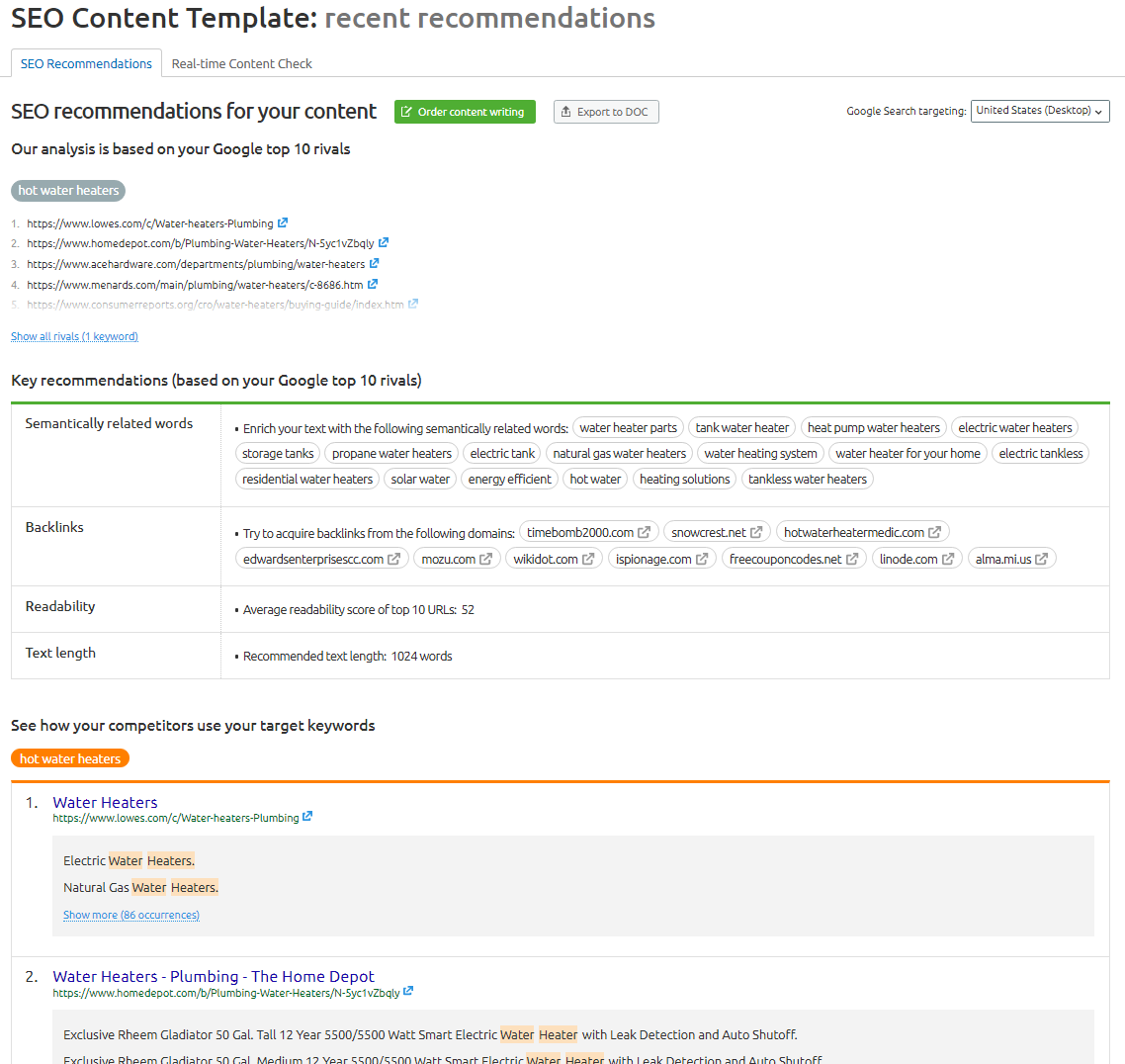
Review Backlinks
Analyzing backlinks is an important part of competitive analysis. When a competitor has a significantly better backlink profile, especially high-quality backlinks from reputable websites, it will mean you will have a more challenging time competing against them until you can build up a similar backlink profile.
It is also essential to distinguish between high-quality backlinks versus low-quality backlinks.
Because Google changed how they handle low-quality links with the Penguin update, if you see a competitor has a high number of low-quality links, those links may not be helping them whatsoever.
If you follow in their footsteps and go for quantity over quality with links, you could harm your SEO. Because you can't see what your competitor's disavowal file is, be wary of wanting to copy competitors directly when it comes to spammier links.
High-Quality Backlinks
You want to focus on high-quality backlinks, such as those from essential news sites, high-profile sites, or experts in your market areas. When looking at competitors' backlinks, consider these questions:
Have they received press in major news organizations? If so, is there any way you can get yourself into similar stories? Are they a recommended source on high-profile but noncommercial sites in your industry? How can you get yourself to be part of those recommended resources?Nofollow vs. Followed Backlinks — Both Can Be Good
You also want to check for nofollow versus followed links. While Google technically doesn't use nofollow links for their algorithms, they won't necessarily help from an SEO standpoint.
However, they can be a vital traffic source that builds your brand awareness, increases traffic, and results in conversions. So do not ignore high-quality links simply because they are nofollow. While the SEO value may not be there, there can be a lot of non-SEO value in all of those links.
Backlink Gaps
You want to look for important gaps in your backlinks, especially links that multiple competitors have from the same page or site. If they have linked to many of your competitors, it is often easy to get yourself listed as well.
Don't forget to check backlinks to strong internal pages of your competitors too. Many only consider links to the homepage for competitive analysis, but links to internal pages can be as important. Some of their strongest performing internal pages could have incoming links that are a significant factor in those pages ranking well.
Analyze Content Types
How do you stack up with different kinds of content compared to your competitors?
For eCommerce sites, product pages are the primary page to compare and look at supporting content each competitor has and how well they are ranking compared to you. This includes news content, blog articles, help/support / how-to content, videos, images, etc. Check anything that could be considered content ranking in the search results.
Identify areas where you lack compared to competitors.
Do they have a regularly published blog that tends to get lots of shares and links? Are they making videos? Infographics? Popular live streams? Podcasts?When you identify competitors that are significantly better for these content types, you can then explore whether you need to add these content types to your site, but you do want to make sure that they add value to your site.
If your competitor has a podcast, yet you can see it has only a handful of downloads, then either your market area does not necessarily need podcasts, or they are doing a lousy job at it. If you can do a vastly superior podcast, you might discover that you can fill that niche.
Search Features
You also want to keep in mind that sometimes these types of content can play a significant role in search features. If Google is displaying these content types in the search results for your top keywords, then it would become a higher priority to make sure you appear in each of the search features to lock down as much of the search result real estate as possible, especially if your competitors do the same.
Identify Search Features
Many overlook the presence or absence of search features in search results when doing a competitor analysis.

While ranking third in the search results might be an excellent result for some searches, it might not be if search features, such as videos, dominate the search result, people also ask, and images. You may need to budget more into those keywords to rank number one while also investing in content that shows in features.
An Opportunity for Ranking
In these types of search results, you will often find that there is potential to take over a significant portion of the search results by adding video they could rank on the page, or tailoring content that would appear in People Also Ask. See what the features there are, and note where you and your competitors appear.
For example, in this search result, you can see the considerable dominance a position one ranking would have over even the second result because of the "People Also Ask" feature. If I were #2 or beyond, I would escalate the goal to work on both getting the top result and appearing in "People Also Ask."
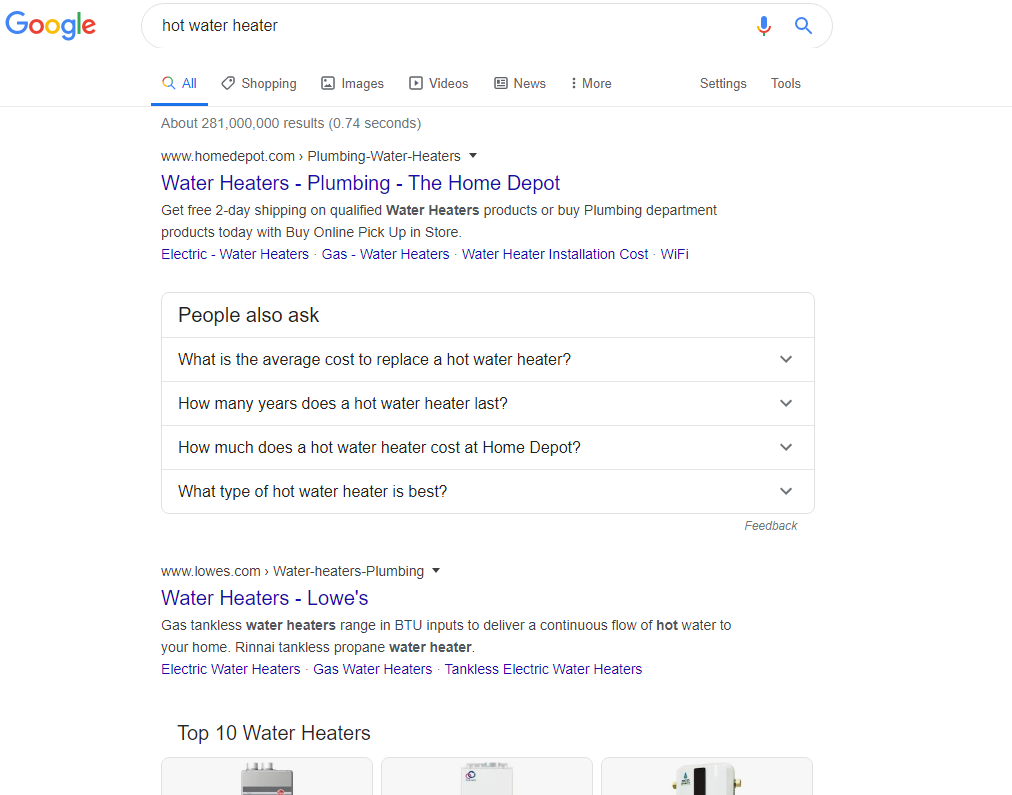
There is greater importance for this type of search with multiple search features on that first position. The second result isn't that great when People Also Ask appears above it, and the third result isn't even seen above the fold on the desktop.
Choosing a Featured Snippet to Focus On
If I decide that my site's most crucial search feature is featured snippets, then I would look at each of my competitors and identify their featured snippets. Then, look at the URL the snippet links to and see if I have a relative URL that I feel would be a good fit for taking over the featured snippet.
How can you tweak each page so Google would select it as a featured snippet?
Here are Home Depot's featured snippets sorted by keyword volume:
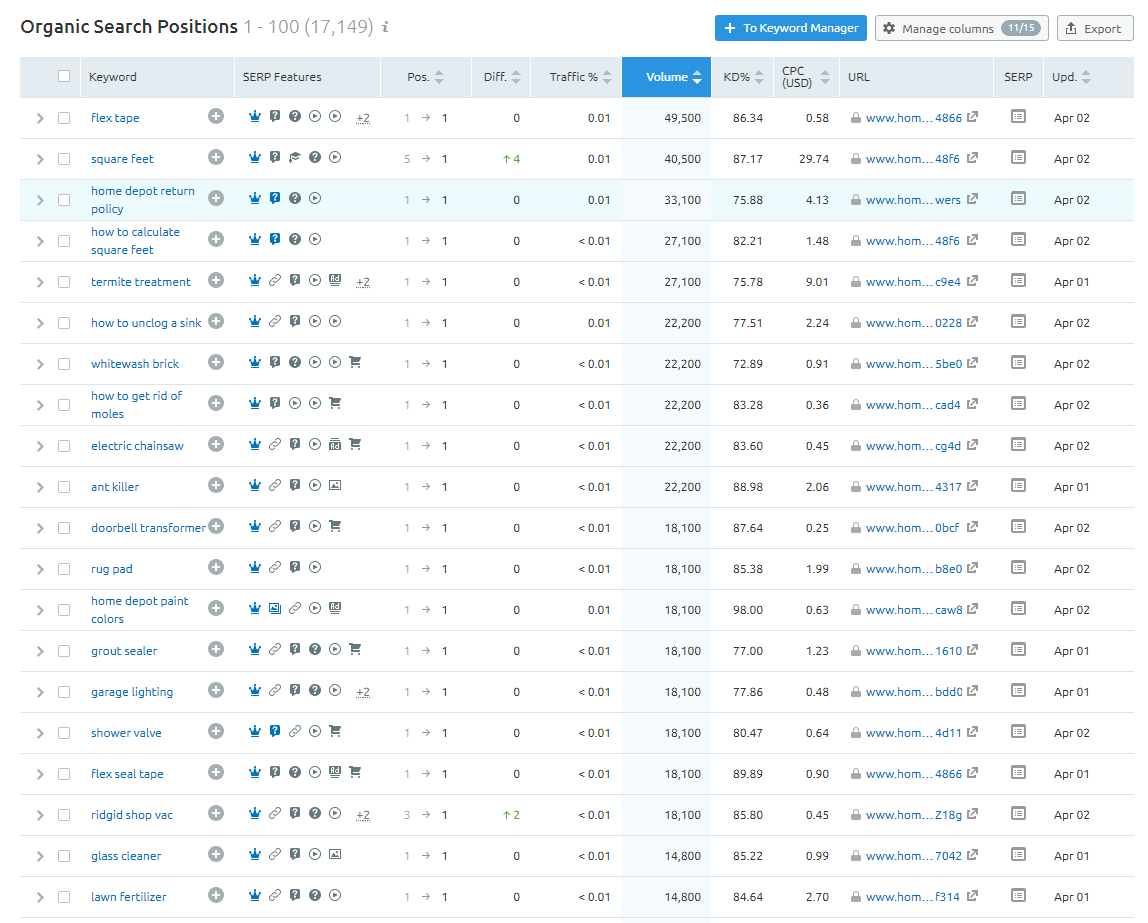
Looking at the above list, a few things stand out. While Home Depot has a lot of featured snippets, they are missing out on the majority of the other search features aside from a few "People Also Ask."
So if I were Home Depot's competitor, I would look heavily at trying to get some of those search features that Home Depot is missing out on while also trying to beat them in the ten blue links.
Comparing Lowe's to Home Depot, while Lowe's has much fewer featured snippets, they appear in many more video carousels than Home Depot does. So each of your competitors may have a handle on a different part of the Google search results, and it is important to note each for a thorough analysis.
Going Beyond Keywords — Providing Solutions
It is worth noting that when you are doing competitive research, you do not want to only look at the "buy" or product keywords. For example, Home Depot has several "how-to" keywords ranking with a significant search volume.
The search results for "how to unclog a sink" have a prominently featured snippet for Home Depot that would entice click-throughs. It leads to a help page with links to products used in the video or step-by-step, which would generate revenue.
Side Note: Not all search features are available in all countries. So ensure that the search features you are targeting display within the country you are targeting.
Schema Tips
While some search features are extracted from content on the page, other search features use schema. For schema-based search features, it often makes sense to add the appropriate schema to a page if you are updating it, even if Google doesn't currently support it as an active search feature in their search results.
Once Google turns on a search feature that uses that particular schema, you will be ahead of the game, and your site will be one of the first in your industry to have it. Likewise, you want to watch your competitor's essential pages to see if they are doing the same by implementing schema before Google officially uses it.
Shoot for Featured Snippets
Featured snippets can sometimes be much easier to take over from a competitor than a number one rankings. Google wants to ensure that featured snippets are accurate, concise, and give the searcher what they are looking for.
So as you look at competitors' featured snippets, see how you can adjust your content for pages ranking in the same SERP to take over the featured snippet.
Using Home Depot as an example, you can see they have been mostly increasing the number of featured snippets monthly, so chances are pretty high they are actively optimizing for it.
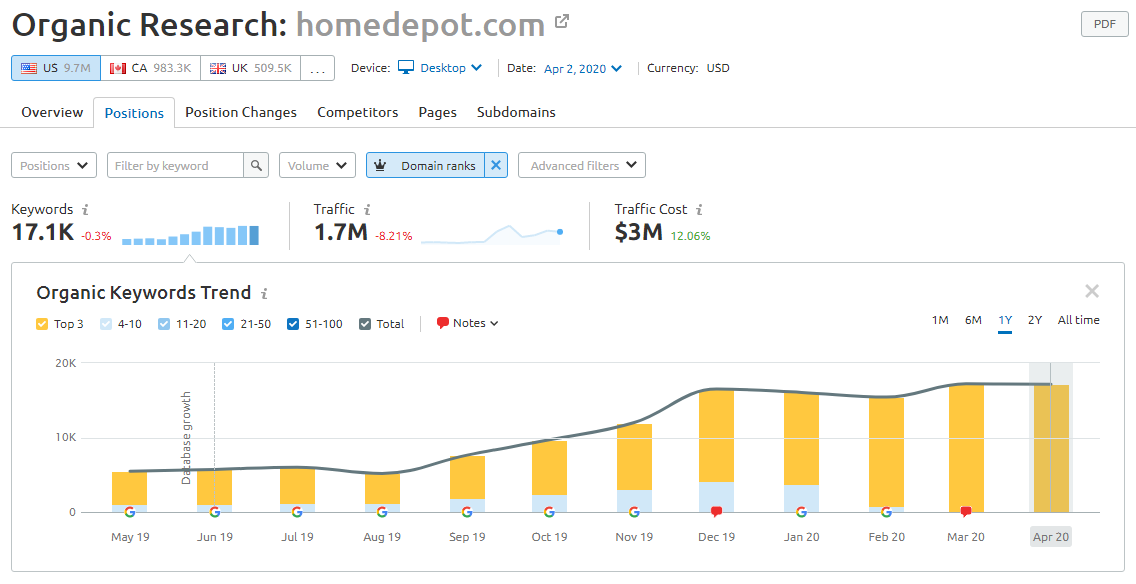
However, looking at Lowe's, it shows they have been losing many of theirs, so likely, some of those snippets would be easy to take over from them.
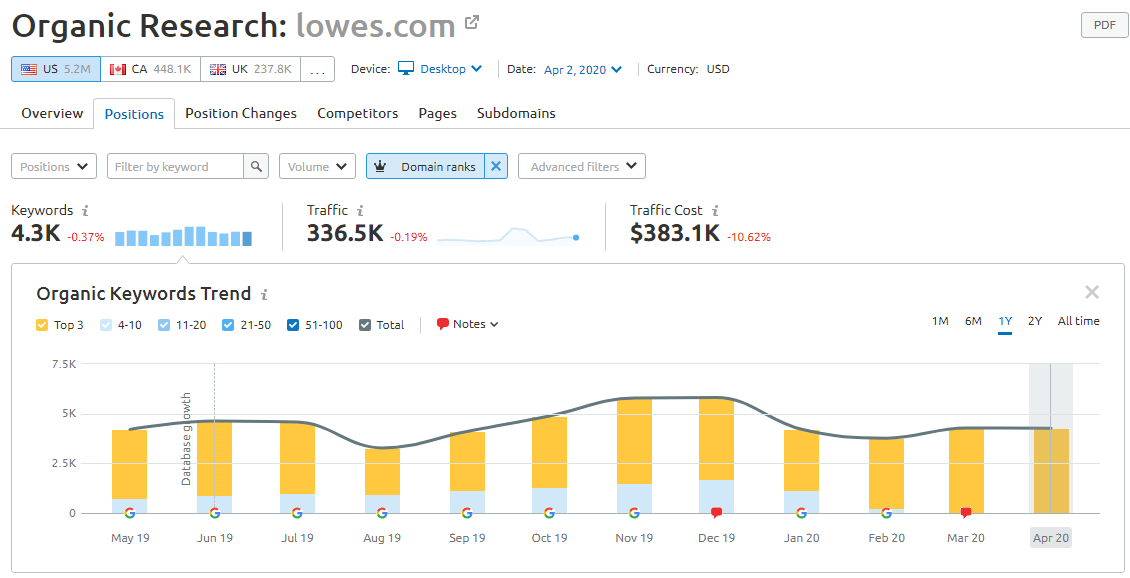
Once you determine which keywords you want to earn featured snippets for and have created content around those terms, you can use the Position Tracking Tool to track your website's daily rankings for each keyword.
You can set the tool to monitor featured snippets and alert you to any changes on SERPs:
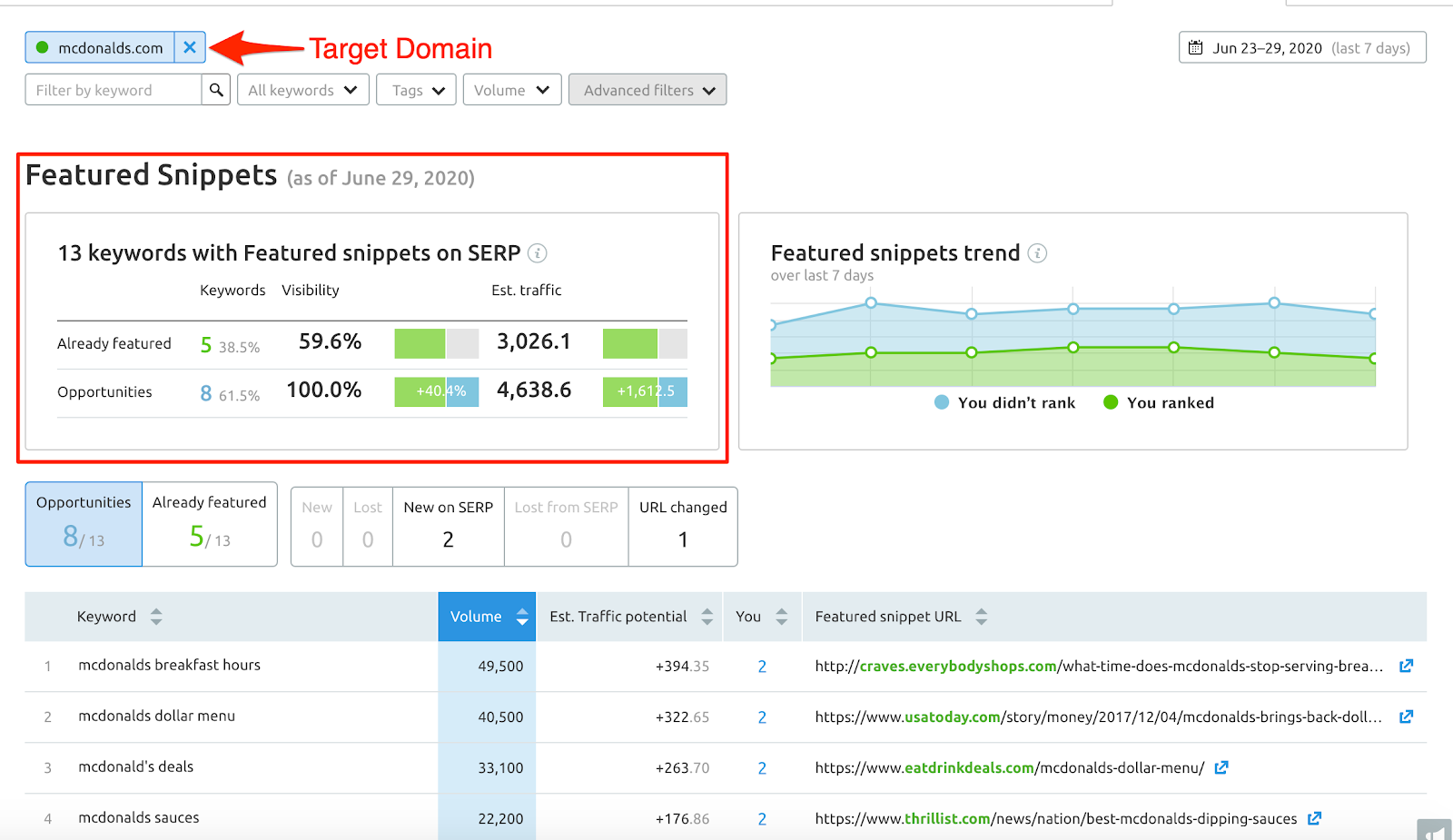
What to Do After Major Algorithm Updates
Whenever there is a major Google algorithm update, you must go back and reevaluate your most important keywords.
Did you retain your rankings? Did one of your competitors come out of nowhere and are suddenly ranking at the top for your keywords? Did another competitor altogether drop out of the space, and you can capitalize on that?Competitive analysis will never be complete; it should never be one and done.
While doing an in-depth analysis, take the time to analyze every aspect of all sites in your market area; don't forget that it is a continuing process. Things change with algorithm updates, site migrations, new pages, and new search features being released. It is essential to revisit and see what has changed since the last deep dive.
And sometimes, it is not even that your competitors have suddenly changed things to make them rank higher when an algorithm update comes. It could have been something they were doing better all along, but Google slightly tweaked something to reward that.
With competitive analysis, you hopefully could identify whatever your competitors are doing better earlier and then make the changes before an algorithm update happens.
Final Thoughts
Depending on the size of your site and the number of active competitors, you will want to rerun a competitor analysis every six months to one year. Parts of it you should perform every month to remain competitive. Keep an eye on changes competitors are making so you can react to their strategies quickly.
A competitive analysis will never technically be complete, whether it is watching for new pages, new keywords, or a rise in search features such as featured snippets. As sites evolve and search results evolve, keeping an eye on your competitors means you will hopefully stay one step ahead of them.
Innovative SEO services
SEO is a patience game; no secret there. We`ll work with you to develop a Search strategy focused on producing increased traffic rankings in as early as 3-months.
A proven Allinclusive. SEO services for measuring, executing, and optimizing for Search Engine success. We say what we do and do what we say.
Our company as Semrush Agency Partner has designed a search engine optimization service that is both ethical and result-driven. We use the latest tools, strategies, and trends to help you move up in the search engines for the right keywords to get noticed by the right audience.
Today, you can schedule a Discovery call with us about your company needs.
Source:





